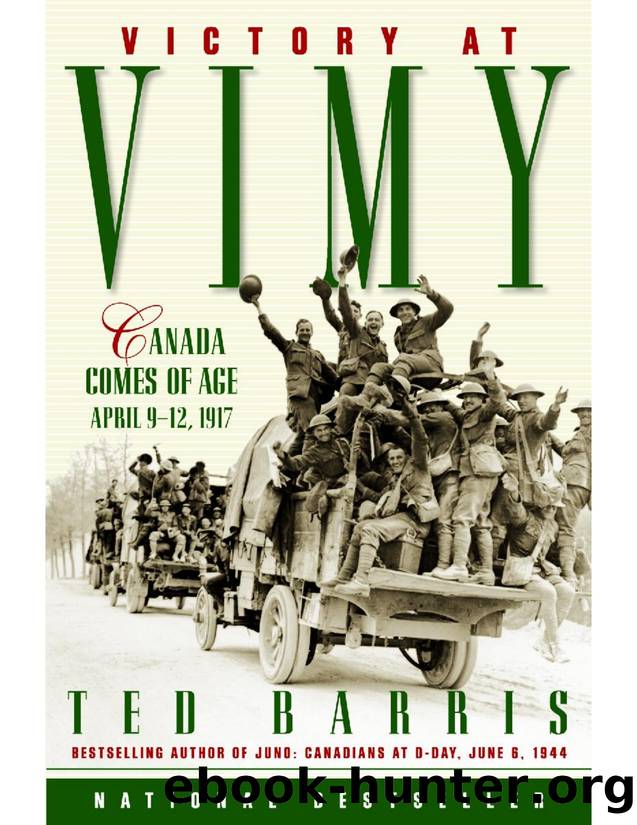Victory at Vimy by Ted Barris

Author:Ted Barris
Language: eng
Format: epub
Publisher: Dundurn Press
Published: 2006-12-11T19:12:16+00:00
9 a.m. April 9, 1917âsouth of Hill 145, 3rd Division sector, Vimy
On the battlefield the Canadian Corps appeared like an army of privates. Partly as a means of protecting its officers from snipers, but also as a psychological lift for the rank and file, Canadian Army officers in
No Manâs Land this day only wore rank insignia on their lapels. The only other aspect that differentiated officers from enlisted men was that they carried revolvers, not rifles. Eric Finley, a major with the 42nd Battalion, recalled âit was the first time that officers wore privatesâ uniforms.â
Initially his battalionâthe Black Watch of Montrealâmoved for- ward in the first wave of the 7th Brigade attack in the 3rd Division sector. With the creeping barrage ahead of them âwe were conscious of the fact that we were all bending our heads down,â but the only resistance they encountered came from the left, where the Germans used enfilade fire from the top of Hill 145. It was further evidence that the German resistance atop Hill 145 was hampering the Canadian advance in both the 3rd and 4th Division sectors. About a third of a mile into the enemy lines, Finley took a flat piece of shrapnel in his back and was knocked unconscious. When he eventually came to, and caught up with his battalion, his men were charging German gun emplacements with bayonets, while Germans fought back with potato-masher grenades. In the fighting, Finley emptied his revolver into enemy troops, but was then struck down by a blow to the helmet. The next thing he knew, he was lying in a shell hole. Snow was falling and a Canadian was leaning over him.
âWell, theyâve got you at last, Eric,â Rev. George Kilpatrick joked.
Finley smiled back at the familiar face of the regimental chaplain, who was in the battlefield assisting stretcher bearers and medics with the 3rd Division.
âCan you make it home?â Kilpatrick asked.
âIâve got to try,â Finley said.
âThe fire is very, very bad,â the reverend pointed out as he linked Finley up with another wounded Canadian so the two could lean on each other en route back to a first aid station. Before they began limp-ing away from the battlefield, however, the two Canadians offered assistance to a wounded Germanâjust a boy, Finley rememberedâ and pulled him between them as they walked. They had barely made it away from the original shell hole when a shot blew through the young German.
âThe boy was killed right under our noses,â Finley said. âHis heart was shot out of his body by a dumdum bullet. All he said was âErrrâ and he was dead before he hit the ground.â
Throughout the day, Rev. Kilpatrick continued moving about the battlefield, assisting medical staff as they treated the wounded. At every step the Canadian medics also seemed to gather more and more German prisoners. At one point Kilpatrick joined a doctor going âdown into a German dugout, armed with nothing but a flashlight and a pair of scissors and [we] brought up five husky prisoners.
Download
This site does not store any files on its server. We only index and link to content provided by other sites. Please contact the content providers to delete copyright contents if any and email us, we'll remove relevant links or contents immediately.
The Radium Girls by Kate Moore(10901)
The Templars by Dan Jones(4181)
100 Deadly Skills by Clint Emerson(4070)
Rise and Kill First by Ronen Bergman(4008)
The Doomsday Machine by Daniel Ellsberg(3725)
The Rape of Nanking by Iris Chang(3506)
Killing England by Bill O'Reilly(3448)
Hitler in Los Angeles by Steven J. Ross(3430)
Stalin by Stephen Kotkin(3081)
12 Strong by Doug Stanton(3052)
Hitler's Monsters by Eric Kurlander(2727)
Darkest Hour by Anthony McCarten(2643)
Blood and Sand by Alex Von Tunzelmann(2605)
The Art of War Visualized by Jessica Hagy(2408)
Hitler's Flying Saucers: A Guide to German Flying Discs of the Second World War by Stevens Henry(2290)
The Code Book by Simon Singh(2201)
The Second World Wars by Victor Davis Hanson(2131)
Babylon's Ark by Lawrence Anthony(2066)
Tobruk by Peter Fitzsimons(2055)
